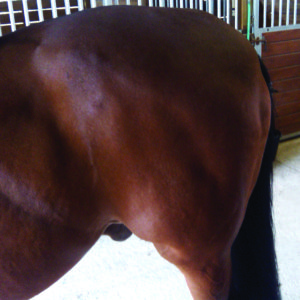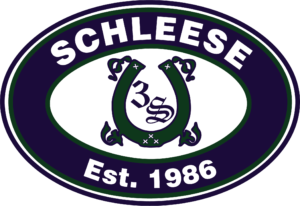A Sad But True Story
 The horse is standing with its hind legs splayed and out of body alignment, which indicates the amount of pain this animal is in even when standing still.
The horse is standing with its hind legs splayed and out of body alignment, which indicates the amount of pain this animal is in even when standing still.
To follow is a sad, but all too common story from my own experiences…
I want to tell you about a horse I met recently; a personal encounter that, unfortunately, is not uncommon in the hundreds and thousands that I work with during the course of a year.
I was called out by the owner of a horse who indicated to me that she was having difficulties with the horse under saddle. I was supposed to perform one of our 80-point diagnostic evaluations onsite and determine the possible cause for some of the issues she was experiencing. When I came to the barn, neither the owner nor the trainer were available.
I was shocked, as the groom brought out this beautiful, but somehow incredibly sad looking horse. I have rarely encountered such an absolute picture of the utmost dejection – someone or something had totally sucked the life out of it. With some probing, I learned that the owner rode her horse maybe twice a month; it was the trainer who rode it for the most part – with his own saddle (which he used for pretty much every horse he trained). This saddle was clearly too narrow in the gullet channel, with the result that the saddle constantly pressed on the spinal vertebral processes and was causing nerve damage.
In addition, the saddle was much too long for this horse’s saddle support area, and lay on its back about 1 ½” behind the 18th lumbar vertebra. As I watched the groom ride the horse in order to do a proper dynamic fit, the saddle began sliding forward on the shoulder already during the walk – which at best affected the horse’s freedom of movement, at worst could cause chipping at the cartilaginous cap. As you can sort of see in the photo, the horse is standing with its hind legs splayed and out of body alignment, which indicates the amount of pain this animal is in even when standing still.
I could continue with further points to illustrate the sad state of affairs this horse was in, but what really made me angry and even sadder was the fact that this horse was being sold because it was “difficult to handle for the owner” and just “too much horse.” Too much horse? The animal was simply reacting in a way that would lessen the pain, or avoid the pain.
In many years of experience as both a rider and a saddle maker and fitter I have discovered that, for the most part, a horse will always try to indicate to us that something is amiss before the ‘bad behaviour’ becomes the norm. Horses cannot speak, so we need to learn to read the signals. Unfortunately, many times the rider is too inexperienced and the trainer too arrogant to listen. They ignore the signals and manipulate, accommodate, punish – sometimes to the point that the SPCA needs to get involved.
Defensive actions by the horse are often its last option and last attempt to escape its fate. These behaviours, however, are often considered to be simple stubbornness or contrariness, and are punished with spurs, whips, or increasingly strong half halts, which impact the sensitive mouth. The horse really has no chance and resigns itself to the reality of the situation. If only they could react with tears or by voicing their discomfort, they may get more empathy from their riders. These difficulties in cross-species communication (often simply because we humans don’t really want to understand!) often results in getting rid of the horse manifesting this ‘unpredictable behaviour’ as a commodity, without considering that the cause could actually be our fault and nothing to do with the horse’s character.
In this sad, but, unfortunately, not rare situation a number of unfortunate factors came together: an absolutely inappropriate saddle, which wasn’t fitted to this horse nor made for this horse; poor training methodology; insufficient empathy and knowledge from both the trainer and the owner. If nothing else, however, this story served to strengthen my focus in life and showed me that I am on the right path. Education and cooperation between owners, trainers, veterinarians, farriers, and other equine professionals is critical if something is to change – and ultimately result in a correctly fitting saddle (the interface between all of these influencers).
